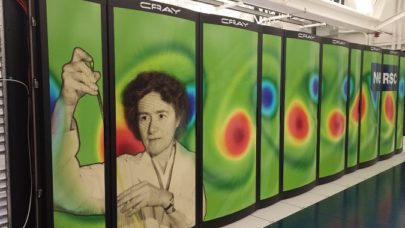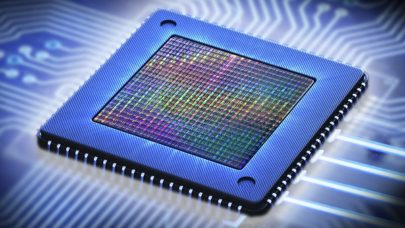
NERSC Cori Shows the World How Many-Cores for the Masses Works
April 21, 2017
As its mission, the high performance computing center for the U.S. Department of Energy Office of Science, NERSC (the National Energy Research Supercomputer Cen Read more…

OpenACC Expands Community, Reveals Roadmap Details
November 7, 2016
In advance of the SC16 expo in Salt Lake City next week, the OpenACC standards group today welcomed newest member NSSC-Wuxi and highlighted a number of important developments for the directives-based programming standard. Ahead of the announcement, HPCwire spoke with Michael Wolfe, technical director of OpenACC, and Duncan Poole, OpenACC president and director of platform alliances for accelerated computing at Nvidia. Read more…

On-Chip Device Accelerates Core-to-Core Communication
September 13, 2016
A team of engineers from North Carolina State University and Intel have joined forces to address on-chip communications bottlenecks that hamper performance scal Read more…

Why 2016 Is the Most Important Year in HPC in Over Two Decades
August 23, 2016
In 1994, two NASA employees connected 16 commodity workstations together using a standard Ethernet LAN and installed open-source message passing software that a Read more…

Mellanox Spins EZchip/Tilera IP Into BlueField Networking Silicon
June 1, 2016
Mellanox today introduced the BlueField family of programmable processors, the first product technology based on its $811 million acquisition of fellow Iraeli high-tech company EZchip. The fact that the product announcement is taking place just three months after the completion of the purchase speaks to the strong synergies between EZchip and Mellanox, said Bob Doud, senior director of marketing at Mellanox. Read more…

James Reinders: Parallelism Has Crossed a Threshold
February 4, 2016
Is the parallel everything era here? What happens when you can assume parallel cores? In the second half of our in-depth interview, Intel's James Reinders discu Read more…

Processor Diversity on the Rise, Reports Intersect360
November 12, 2015
Intel x86 processors continue to dominate HPC servers while the number of cores per processor also keeps rising, perhaps no surprises there. Also somewhat antic Read more…

OpenACC Reviews Latest Developments and Future Plans
November 11, 2015
This week during the lead up to SC15 the OpenACC standards group announced several new developments including the release and ratification of the 2.5 version of Read more…

- Click Here for More Headlines

Whitepaper
Transforming Industrial and Automotive Manufacturing
In this era, expansion in digital infrastructure capacity is inevitable. Parallel to this, climate change consciousness is also rising, making sustainability a mandatory part of the organization’s functioning. As computing workloads such as AI and HPC continue to surge, so does the energy consumption, posing environmental woes. IT departments within organizations have a crucial role in combating this challenge. They can significantly drive sustainable practices by influencing newer technologies and process adoption that aid in mitigating the effects of climate change.
While buying more sustainable IT solutions is an option, partnering with IT solutions providers, such and Lenovo and Intel, who are committed to sustainability and aiding customers in executing sustainability strategies is likely to be more impactful.
Learn how Lenovo and Intel, through their partnership, are strongly positioned to address this need with their innovations driving energy efficiency and environmental stewardship.
Download Now
Sponsored by Lenovo
Whitepaper
How Direct Liquid Cooling Improves Data Center Energy Efficiency
Data centers are experiencing increasing power consumption, space constraints and cooling demands due to the unprecedented computing power required by today’s chips and servers. HVAC cooling systems consume approximately 40% of a data center’s electricity. These systems traditionally use air conditioning, air handling and fans to cool the data center facility and IT equipment, ultimately resulting in high energy consumption and high carbon emissions. Data centers are moving to direct liquid cooled (DLC) systems to improve cooling efficiency thus lowering their PUE, operating expenses (OPEX) and carbon footprint.
This paper describes how CoolIT Systems (CoolIT) meets the need for improved energy efficiency in data centers and includes case studies that show how CoolIT’s DLC solutions improve energy efficiency, increase rack density, lower OPEX, and enable sustainability programs. CoolIT is the global market and innovation leader in scalable DLC solutions for the world’s most demanding computing environments. CoolIT’s end-to-end solutions meet the rising demand in cooling and the rising demand for energy efficiency.
Download Now
Sponsored by CoolIT
Advanced Scale Career Development & Workforce Enhancement Center
Featured Advanced Scale Jobs:
HPCwire Resource Library
HPCwire Product Showcase
© 2024 HPCwire. All Rights Reserved. A Tabor Communications Publication
HPCwire is a registered trademark of Tabor Communications, Inc. Use of this site is governed by our Terms of Use and Privacy Policy.
Reproduction in whole or in part in any form or medium without express written permission of Tabor Communications, Inc. is prohibited.
























